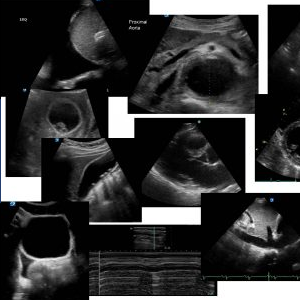
Kathryn Statham
Aortic stenosis
- It is the most common valvular heart disease in developed countries
- It’s prevalence is increasing with our ageing population
- It is found in 3% of patients > 75 yrs
- It is the most common valve disease requiring surgical intervention in developed countries. TAVI is increasingly the treatment of choice for severe AS
- Aortic sclerosis is a precursor of aortic stenosis and present in 25% of patients > 65 yrs
Causes
- Congenital (unicuspid and bicuspid)
- Acquired (calcific and rheumatic)




Aortic stenosis aetiology: Morphology of calcific AS, bicuspid valve and rheumatic AS (adapted from C Otto Practice of clinical echocardiography 2007 )
1.Congenital
Please also refer to the previous post : https://www.criticalcare-sonography.com/2020/02/20/3-causes-of-aortic-regurgitation-congenitally-abnormal-valves/
Unicuspid aortic valve
- One solitary opening and one point attachment to the aorta
- Very rare
- Typically stenotic at birth
Bicuspid valve
- Most common cardiac congenital abnormality
- Most common cause of isolated AS in patients under 50
- Accelerated calcification is common with premature stenosis
- The bicuspid valve can either be a “true ” bicuspid valve (BAV) (2 commissures) or a BAV with a “raphe”


 “
“
True” bicuspid aortic valve (no raphe)
Bicuspid valve with Raphe (arrow)
Calcified Bicuspid Valve
Features on ECHO which may indicate a bicuspid valve
- Eccentric flow and/or eccentric regurgitation
- Aortic dilatation (BAV is associated with aortopathies)
- Abnormal thickening of the valve leaflets in a young person
- Systolic doming or “skipping rope” appearance from PLAX view
- Eccentric closure on M-mode
- LVH without a history of hypertension

- Eccentric AR seen from apical 5 chamber view


2. Eccentric leaflet closure on M mode


Closure in normal AV below


3. Systolic doming or “skipping rope” appearance from PLAX view


Systolic doming or “skipping” rope appearance of the leaflets
2.Acquired
In acquired aortic stenosis there are 3 leaflets and visible calcification with reduced leaflet excursion
a. Senile calcification
- deposition of calcium on trileaflet aortic valve
- most common type of aortic stenosis in western world
- generally occurs in 80s & 90s
- cusps are immobilized by calcium deposits
- may have concomitant mitral annular calcification or coronary artery disease
- commissural fusion is absent

Calcific aortic stenosis from PSAX view
Severe calcific aortic stenosis from PLAX view
b. Rheumatic heart disease
- Most commonly seen in developing countries
- Caused by acute episode of rheumatic fever
- There is less calcification & more commissural fusion
- Almost always accompanied by rheumatic mitral disease
- Often also results in aortic regurgitation due to poor leaflet coaptation
- Leaflets are thickened with focal calcification

Severe rheumatic aortic stenosis with visible coaptation defect
Rheumatic aortic valve. (note rheumatic mitral valve)
Severe rheumatic aortic stenosis (note rheumatic mitral valve)
References
- The practice of clinical echocardiography by Catherine Otto 5th edition Elsevier





